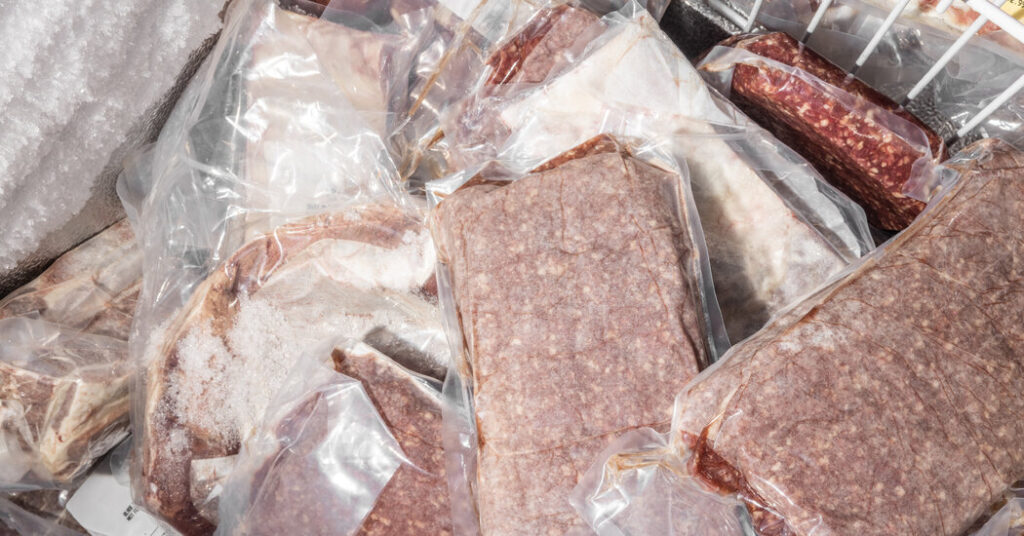They’re called “forever chemicals” because they basically never break down. They’re linked to ailments including liver disease, certain types of cancers and delayed development in children.
It’s now becoming apparent that these synthetic chemicals, collectively known by the acronym PFAS, have also been unwittingly spread on American farmland for years through the use of sewage sludge as fertilizer. That sludge can have high concentrations of such chemicals.
The most common way that people are exposed is likely by eating contaminated food or water, according to the federal government.
What does this mean for personal health? Here’s what we know and don’t know.
How widespread are PFAS in food?
It’s unclear the extent to which PFAS are reaching the food we consume, whether from sludge-treated farmland or from other sources. PFAS have been widely used for years in things like nonstick cookware, food containers and countless other products.
The U.S. Food and Drug Administration does not set limits on PFAS levels in food. But, responding to rising public concerns, the agency has tested nearly 1,300 samples for PFAS and has found the vast majority, 97 percent, free of the types of PFAS that the agency is currently able to test for.
That’s the good news.
Still, some public-health advocacy groups have questioned the F.D.A.’s methodology, and the agency itself warns that “PFAS exposure from food is an emerging area of science and there remains much we do not yet know.” This year, Consumer Reports said it had detected PFAS in some milk, including in brands marketed as organic, and researchers have found the chemicals in products as varied as eggs, fruit juice and seafood.
Does buying organic avoid contamination?
Farmers that are certified as organic are prohibited from using sewage sludge. But that doesn’t put all organic farms in the all clear.
Because PFAS persist for so long in the environment, chemicals can be left behind in the soil from contaminated sludge fertilizer put down decades ago. Still, scientists say organic farming comes with benefits: It exposes workers to fewer pesticides, for example, and can also improve biodiversity and water quality. And, organic food may lower your cancer risk.
What are PFAS anyway?
PFAS refers to a class of versatile, synthetic chemicals whose structures make them resistant to water and grease. That’s why they’ve been used so widely. They even been used in stain-resistant carpets, firefighting foam and dental floss.
PFAS is an acronym for per- and polyfluoroalkyl substances. It’s a class of thousands of different chemicals with similar properties.
A growing body of research shows that exposure can increase the risk of prostate, kidney and testicular cancers. The chemicals have also been linked to low birth weight, birth defects and developmental delays in children, as well as thyroid disease and high cholesterol.
This year, the Environmental Protection Agency said there’s no safe level of PFAS exposure for humans and imposed limits on some PFAS in drinking water.
Rachel Criswell, an environmental health researcher and family physician in Skowhegan, Maine, who works with communities affected by PFAS exposure, says that PFAS rarely cause acute symptoms. But they’re a risk factor for a wide range of diseases and “something we should be aware of and that we need to monitor,” she said.
How does this end up in farm fertilizer?
The wastewater that flows from homes and factories is treated at sewage plants. That process produces loads of sewage sludge, which then gets used as fertilizer on farmland.
So far, so good.
Treatment plants clean the sewage of contaminants like pathogens and heavy metals. But historically they haven’t been required to remove, or even test for, PFAS, despite the fact that industrial wastewater can sometimes contain considerable amounts. Research has also shown that treating wastewater can concentrate the chemicals or even transform them into more problematic compounds.
When sludge fertilizer containing PFAS is applied to farmland, the chemicals get into the soil and water. Plants pick up the chemicals, which then get into animals that eat the plants or drink the water. Fish, too, can get it from living in contaminated water.
From there, the PFAS can enter the human food chain. Experts say contamination of farmland could be an under-studied and little understood route of exposure.
The E.P.A. regulates some pathogens and heavy metals in sludge fertilizer, but not PFAS. Microplastics and other pollution can also get into fertilizer, and those aren’t regulated, either.
How much farmland is affected?
It’s difficult to know exactly.
For decades, the E.P.A. has encouraged using sludge to fertilize farmland nationwide. Not only is it full of nutrients, but all that sludge would otherwise have to go into landfills or be burned. And, in decades past, there was less awareness of the PFAS risk.
The E.P.A.’s data on sludge fertilizer use is incomplete. The fertilizer industry says more than 2 million dry tons were used on 4.6 million acres of farmland in 2018. And it estimates that farmers have obtained permits to use sewage sludge (which the industry calls biosolids) on nearly 70 million acres, or about a fifth of all U.S. agricultural land.

